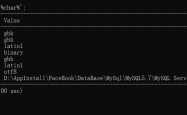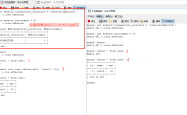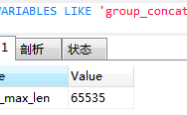mysql in语句子查询效率慢的优化技巧示例
表结构如下,文章只有690篇。
?| 1 2 3 | 文章表article(id,title,content) 标签表tag(tid,tag_name) 标签文章中间表article_tag(id,tag_id,article_id) |
其中有个标签的tid是135,查询标签tid是135的文章列表。
690篇文章,用以下的语句查询,奇慢:
?| 1 2 3 | select id,title from article where id in ( select article_id from article_tag where tag_id=135 ) |
其中这条速度很快:
?| 1 | select article_id from article_tag where tag_id=135 |
查询结果是五篇文章,id为428,429,430,431,432
用下面sql来查文章也很快:
?| 1 2 3 | select id,title from article where id in ( 428,429,430,431,432 ) |
解决方法:
?| 1 2 3 | select id,title from article where id in ( select article_id from ( select article_id from article_tag where tag_id=135) as tbt ) |
其它解决方法:(举例)
?| 1 | mysql> select * from abc_number_prop where number_id in ( select number_id from abc_number_phone where phone = '82306839' ); |
为了节省篇幅,省略了输出内容,下同。
67 rows in set (12.00 sec)
只有67行数据返回,却花了12秒,而系统中可能同时会有很多这样的查询,系统肯定扛不住。用desc看一下(注:explain也可)
?| 1 2 3 4 5 6 7 8 | mysql> desc select * from abc_number_prop where number_id in ( select number_id from abc_number_phone where phone = '82306839' ); + ----+--------------------+------------------+--------+-----------------+-------+---------+------------+---------+--------------------------+ | id | select_type | table | type | possible_keys | key | key_len | ref | rows | Extra | + ----+--------------------+------------------+--------+-----------------+-------+---------+------------+---------+--------------------------+ | 1 | PRIMARY | abc_number_prop | ALL | NULL | NULL | NULL | NULL | 2679838 | Using where | | 2 | DEPENDENT SUBQUERY | abc_number_phone | eq_ref | phone,number_id | phone | 70 | const,func | 1 | Using where ; Using index | + ----+--------------------+------------------+--------+-----------------+-------+---------+------------+---------+--------------------------+ 2 rows in set (0.00 sec) |
可以看出,在执行此查询时会扫描两百多万行,难道是没有创建索引吗,看一下
?| 1 2 3 4 5 6 7 8 9 10 11 12 13 14 15 16 17 18 19 20 21 22 | mysql>show index from abc_number_phone; + ------------------+------------+-------------+--------------+-----------------+-----------+-------------+----------+--------+------+------------+---------+---------------+ | Table | Non_unique | Key_name | Seq_in_index | Column_name | Collation | Cardinality | Sub_part | Packed | Null | Index_type | Comment | Index_comment | + ------------------+------------+-------------+--------------+-----------------+-----------+-------------+----------+--------+------+------------+---------+---------------+ | abc_number_phone | 0 | PRIMARY | 1 | number_phone_id | A | 36879 | NULL | NULL | | BTREE | | | | abc_number_phone | 0 | phone | 1 | phone | A | 36879 | NULL | NULL | | BTREE | | | | abc_number_phone | 0 | phone | 2 | number_id | A | 36879 | NULL | NULL | | BTREE | | | | abc_number_phone | 1 | number_id | 1 | number_id | A | 36879 | NULL | NULL | | BTREE | | | | abc_number_phone | 1 | created_by | 1 | created_by | A | 36879 | NULL | NULL | | BTREE | | | | abc_number_phone | 1 | modified_by | 1 | modified_by | A | 36879 | NULL | NULL | YES | BTREE | | | + ------------------+------------+-------------+--------------+-----------------+-----------+-------------+----------+--------+------+------------+---------+---------------+ 6 rows in set (0.06 sec) mysql>show index from abc_number_prop; + -----------------+------------+-------------+--------------+----------------+-----------+-------------+----------+--------+------+------------+---------+---------------+ | Table | Non_unique | Key_name | Seq_in_index | Column_name | Collation | Cardinality | Sub_part | Packed | Null | Index_type | Comment | Index_comment | + -----------------+------------+-------------+--------------+----------------+-----------+-------------+----------+--------+------+------------+---------+---------------+ | abc_number_prop | 0 | PRIMARY | 1 | number_prop_id | A | 311268 | NULL | NULL | | BTREE | | | | abc_number_prop | 1 | number_id | 1 | number_id | A | 311268 | NULL | NULL | | BTREE | | | | abc_number_prop | 1 | created_by | 1 | created_by | A | 311268 | NULL | NULL | | BTREE | | | | abc_number_prop | 1 | modified_by | 1 | modified_by | A | 311268 | NULL | NULL | YES | BTREE | | | + -----------------+------------+-------------+--------------+----------------+-----------+-------------+----------+--------+------+------------+---------+---------------+ 4 rows in set (0.15 sec) |
从上面的输出可以看出,这两张表在number_id字段上创建了索引的。
看看子查询本身有没有问题。
| 1 2 3 4 5 6 7 | mysql> desc select number_id from abc_number_phone where phone = '82306839' ; + ----+-------------+------------------+------+---------------+-------+---------+-------+------+--------------------------+ | id | select_type | table | type | possible_keys | key | key_len | ref | rows | Extra | + ----+-------------+------------------+------+---------------+-------+---------+-------+------+--------------------------+ | 1 | SIMPLE | abc_number_phone | ref | phone | phone | 66 | const | 6 | Using where ; Using index | + ----+-------------+------------------+------+---------------+-------+---------+-------+------+--------------------------+ 1 row in set (0.00 sec) |
没有问题,只需要扫描几行数据,索引起作用了。
查询出来看看:
?| 1 2 3 4 5 6 7 8 9 10 11 12 | mysql> select number_id from abc_number_phone where phone = '82306839' ; + -----------+ | number_id | + -----------+ | 8585 | | 10720 | | 148644 | | 151307 | | 170691 | | 221897 | + -----------+ 6 rows in set (0.00 sec) |
直接把子查询得到的数据放到上面的查询中
?| 1 2 | mysql> select * from abc_number_prop where number_id in (8585, 10720, 148644, 151307, 170691, 221897); 67 rows in set (0.03 sec) |
速度也快,看来MySQL在处理子查询的时候是不够好。我在MySQL 5.1.42 和 MySQL 5.5.19 都进行了尝试,都有这个问题。
搜索了一下网络,发现很多人都遇到过这个问题:
参考资料1:MySQL优化之使用连接(join)代替子查询
参考资料2:MYSQL子查询和嵌套查询优化实例解析
根据网上这些资料的建议,改用join来试试。
修改前:
| 1 | select * from abc_number_prop where number_id in ( select number_id from abc_number_phone where phone = '82306839' ); |
修改后:
?| 1 2 3 | select a.* from abc_number_prop a inner join abc_number_phone b on a.number_id = b.number_id where phone = '82306839' ; mysql> select a.* from abc_number_prop a inner join abc_number_phone b on a.number_id = b.number_id where phone = '82306839' ; 67 rows in set (0.00 sec) |
效果不错,查询所用时间几乎为0。看一下MySQL是怎么执行这个查询的
?| 1 2 3 4 5 6 7 8 | mysql> desc select a.* from abc_number_prop a inner join abc_number_phone b on a.number_id = b.number_id where phone = '82306839' ; + ----+-------------+-------+------+-----------------+-----------+---------+-----------------+------+--------------------------+ | id | select_type | table | type | possible_keys | key | key_len | ref | rows | Extra | + ----+-------------+-------+------+-----------------+-----------+---------+-----------------+------+--------------------------+ | 1 | SIMPLE | b | ref | phone,number_id | phone | 66 | const | 6 | Using where ; Using index | | 1 | SIMPLE | a | ref | number_id | number_id | 4 | eap.b.number_id | 3 | | + ----+-------------+-------+------+-----------------+-----------+---------+-----------------+------+--------------------------+ 2 rows in set (0.00 sec) |
小结:当子查询速度慢时,可用JOIN来改写一下该查询来进行优化。
网上也有文章说,使用JOIN语句的查询不一定总比使用子查询的语句快。
mysql手册也提到过,具体的原文在mysql文档的这个章节:
I.3. Restrictions on Subqueries
13.2.8. Subquery Syntax
摘抄:
1)关于使用IN的子查询:
Subquery optimization for IN is not as effective as for the = operator or for IN(value_list) constructs.
A typical case for poor IN subquery performance is when the subquery returns a small number of rows but the outer query returns a large number of rows to be compared to the subquery result.
The problem is that, for a statement that uses an IN subquery, the optimizer rewrites it as a correlated subquery. Consider the following statement that uses an uncorrelated subquery:
SELECT ... FROM t1 WHERE t1.a IN (SELECT b FROM t2);
The optimizer rewrites the statement to a correlated subquery:
SELECT ... FROM t1 WHERE EXISTS (SELECT 1 FROM t2 WHERE t2.b = t1.a);
If the inner and outer queries return M and N rows, respectively, the execution time becomes on the order of O(M×N), rather than O(M+N) as it would be for an uncorrelated subquery.
An implication is that an IN subquery can be much slower than a query written using an IN(value_list) construct that lists the same values that the subquery would return.
2)关于把子查询转换成join的:
The optimizer is more mature for joins than for subqueries, so in many cases a statement that uses a subquery can be executed more efficiently if you rewrite it as a join.
An exception occurs for the case where an IN subquery can be rewritten as a SELECT DISTINCT join. Example:
SELECT col FROM t1 WHERE id_col IN (SELECT id_col2 FROM t2 WHERE condition);
That statement can be rewritten as follows:
SELECT DISTINCT col FROM t1, t2 WHERE t1.id_col = t2.id_col AND condition;
But in this case, the join requires an extra DISTINCT operation and is not more efficient than the subquery
总结
以上就是本文关于mysql in语句子查询效率慢的优化技巧示例的全部内容,有什么问题可以留言,欢迎大家一起交流参考。
希望本文所述对大家有所帮助。
原文链接:http://www.jquerycn.cn/a_14585
1.本站遵循行业规范,任何转载的稿件都会明确标注作者和来源;2.本站的原创文章,请转载时务必注明文章作者和来源,不尊重原创的行为我们将追究责任;3.作者投稿可能会经我们编辑修改或补充。










